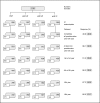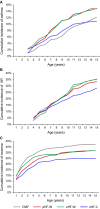Allergic manifestation 15 years after early intervention with hydrolyzed formulas--the GINI Study
- PMID: 26465137
- PMCID: PMC4738469
- DOI: 10.1111/all.12790
Allergic manifestation 15 years after early intervention with hydrolyzed formulas--the GINI Study
Abstract
Background: Data on the long-term impact of hydrolyzed formulas on allergies are scarce.
Objective: To assess the association between early intervention with hydrolyzed formulas in high-risk children and allergic outcomes in adolescence.
Methods: GINI trial participants (n = 2252) received one of four formulas in the first four months of life as breastmilk substitute if necessary: partial or extensive whey hydrolyzate (pHF-W, eHF-W), extensive casein hydrolyzate (eHF-C) or standard cow's milk formula (CMF) as reference. Associations between these formulas and the cumulative incidence and prevalence of parent-reported physician-diagnosed asthma, allergic rhinitis (AR) and eczema, as well as spirometric indices and sensitization, were examined using generalized linear models.
Results: Between 11 and 15 years, the prevalence of asthma was reduced in the eHF-C group compared to CMF (odds ratio (OR) 0.49, 95% confidence interval (CI) 0.26-0.89), which is consistent with the spirometric results. The cumulative incidence of AR was lower in eHF-C (risk ratio (RR) 0.77, 95% CI 0.59-0.99]) and the AR prevalence in pHF-W (OR 0.67, 95% CI 0.47-0.95) and eHF-C (OR 0.59, 95% CI 0.41-0.84). The cumulative incidence of eczema was reduced in pHF-W (RR 0.75, 95% CI 0.59-0.96) and eHF-C (RR 0.60, 95% CI 0.46-0.77), as was the eczema prevalence between 11 and 15 years in eHF-C (OR 0.42, 95% CI 0.23-0.79). No significant effects were found in the eHF-W group on any manifestation,nor was there an effect on sensitization with any formula.
Conclusion: In high-risk children, early intervention using different hydrolyzed formulas has variable preventative effects on asthma, allergic rhinitis and eczema up to adolescence.
Keywords: 15-year follow-up from birth; allergy prevention; double-blind; hydrolyzed infant formulas; nutritional intervention; randomized trial.
© 2015 The Authors. Allergy Published by John Wiley & Sons Ltd.
Figures


References
-
- American Academy of Pediatrics Committee on Nutrition . Hypoallergenic infant formulas. Pediatrics 2000;106:236–347. - PubMed
-
- Muraro A, Dreborg S, Halken S, Høst A, Niggemann B, Aalberse R et al. Dietary prevention of allergic diseases in infants and small children. Part III: critical review of published peer‐reviewed observational and interventional studies and final recommendations. Pediatr Allergy Immunol 2004;15:291–307. - PubMed
-
- Greer FR, Sicherer SH, Burks W, the Committee on Nutrition and Section on Allergy and Immunology . Effects of early nutritional interventions on the development of atopic disease in infants and children: the role of maternal dietary restriction, breastfeeding, timing of introduction of complementary foods, and hydrolyzed formulas. 2008;121:183–191. - PubMed
-
- Fleischer DM, Spergel JM, Assa'ad AH, Pongracic JA. Primary prevention of allergic disease through nutritional intervention. J Allergy Clin Immunol Pract 2013;1:29–36. - PubMed
-
- Prescott S, Tang M, Björksten B. Primary allergy prevention in children: updated summary of a position statement of the Australasian Society of Clinical Immunology and Allergy In: Kemp A, Mullin R, Weiner J, editors. MJA Practice Essentials Allergy. Sydney: Australasian Medical Publishing Company; 2007: 54–58.
Publication types
MeSH terms
Substances
LinkOut - more resources
Full Text Sources
Other Literature Sources
Medical
Research Materials

